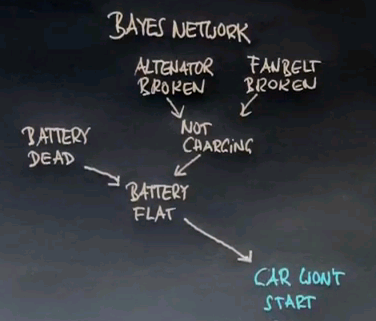AI class unit 3
These are my notes for Week 2 of the AI class.
Probability in AI
Introduction
{{#ev:youtubehd|-8DyY8_IuA0}}
So the next units will be concerned with probabilities. Particularly with structured probabilities using Bayes Networks. This is some of the most involved material in this class. And since this is a Stanford level class you'll find out that some of the quizzes are actually real hard. So as you go through the material I hope the hardness of the quizzes won't discourage you, it'll really entice you, to take a piece of paper and a pen and work them out.
Let me give you a flavour of a Bayes Network using an example. Suppose you find in the morning that your car won't start. Well there are many causes why your car might not start. One is that your battery is flat. Even for a flat battery there's multiple causes: one is that it's just plain dead, and one is that the battery is OK but it's not charging. The reason why a battery might not charge is that the alternator may be broken or the fan belt may be broken. If you look at this influence diagram, also called a Bayes Network, you'd find that there's many different ways to explain that the car won't start, and a natural question you might have is "can we diagnose the problem?"
One diagnostic tool is a battery meter, which may increase or decrease your belief that the battery may cause you car failure. You might also know your battery age -- older batteries tend to go dead more often. Then there's many other ways to look at reasons why the car won't start. You might expect the lights, the oil light, the gas gauge. You might even dip into the engine to see what the oil level is, with a dipstick. And all of those relate to alternative reasons why your car might not be starting, like no oil, or no gas, the fuel line might be blocked, or the starter might be broken. All of these can influence your measurements, like the oil light or the gas gauge, in different ways. For example a flat battery might have an effect on the lights, or the oil light, and on the gas gauge; but it won't really have an effect the oil you measure with a dipstick. That is affected by the oil level, which also affects the oil light. Gas will affect the gas gauge and of course without gas the car doesn't start.

